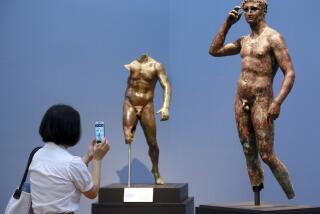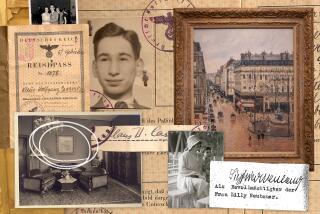Acts of Provenance
J. Paul Getty in 1938 bought a painting of a Holy Family attributed to Raphael, one of the Renaissanceâs most highly revered masters. About 30 copies of the painting were known to exist, but most scholars agreed that the Getty work was probably the original.
In 1975, while Burton Fredericksen was curator of paintings at the J. Paul Getty Museum, he set out to prove it. He encountered one painting in France. âEveryone thought it was a copy,â Fredericksen said. âIt was labeled a copy; it had always been displayed as a copy. No one thought it was an original.â
But when he discovered a number on the back of the French-owned work that coincided with a recently discovered inventory of a collection containing the original, âeveryone changed,â Fredericksen said. Suddenly the French Raphael was the real thing and the Getty work was a copy. âI wish it had been the other way around, but that proves the power of provenance.â
As an art historian, Fredericksen didnât have to be convinced of the value of pursuing art historical trivia, but his experience was a pointed introduction to a field that now demands most of his attention. As director of a 5-year-old, little-known program called the Getty Provenance Index, he oversees an unparalleled effort to sort out and pin down the past histories of artworks.
The Index is a branch of the Getty Art History Information Program, administered by the J. Paul Getty Trust. Currently housed in temporary quarters in Santa Monica, the Index will be part of the J. Paul Getty Center now under construction in Brentwood.
The Getty Provenance Index provides a service to scholars and museums that is offered by no other institution. Gleaning information from old auction catalogues, museum references and the findings of archivists working part time for the Getty in Europe, Fredericksenâs staff of nine art historians compiles information on all aspects of provenance: the whereabouts of individual artworks in previous centuries, who owned them, how much they cost, what they were called and to whom they were attributed.
About 200 times a year, a curator in one of 150 museums throughout the United States and England opens a letter from the Index. In the driest of language, the letter begins: âGiven below is what we believe to be previously unnoticed or unpublished information concerning the provenance of the following painting in your collection.â
The correspondence may only reveal a few details from a recently unearthed auction record, but occasionally the news is a significant discovery. The Getty learned, for example that a painting by Italian master Giuliano Bugiardini now in the Allentown (Pa.) Art Museum could be traced back to the early 16th Century in Bologna.
âGenerally we just fill in the gaps in what museums already know about their collections,â said Fredericksen. âBut sometimes we are able to add a couple of centuries.â
In addition to sending out unsolicited nuggets of information, the Provenance Index answers requests from scholars and museums. Genetta Gardner, assistant curator at the Cincinnati Art Museum, recently sought help with a painting by Andrea Mantegna. The museum could only trace the paintingâs history back to 1872. Gardner hoped that an inventory number found on the back of the painting might be a clue to its earlier years.
Fredericksen ran the number through the Indexâs computer and came up with nothing. But through a serendipitous discovery (while researching another artwork), he soon traced the workâs provenance back to 1603.
âThat was very exciting for us,â Gardner said in a telephone interview. âThe Mantegna is one of our treasures and learning some its early history makes it just that much better.â
So far, the Index is limited to paintings. Documentation reaches as far back as possible but generally cuts off in the 1880s or 1890s when the development of photography, the discipline of art history and improved record-keeping methods make information more accessible and complete. Currently the Index has computerized provenance records of the painting collections in about 150 American and English museums, Fredericksen said. The scope will eventually include European institutions.
The Index has just published its first reference book, âThe Index of Paintings Sold in the British Isles During the Nineteenth Century, Volume I, 1801-1805.â Volume II will cover the next five years.
In addition to provenance files, the Index maintains files on collectors (with assorted sheets of information assembled in old-fashioned filing cabinets), an automated index to sales (primarily public auctions) held during the 19th Century in Britain and a computerized index of various inventories including about 40,000 artworks.
âItâs an enormous jigsaw puzzle,â Fredericksen said, and one that will never be finished. But as pieces fall into place and get logged into the computer, scholars can determine much more than the history of a single work of art. âYou can locate all the portraits of the Earl of Pembroke or what paintings by Fra Angelico the Pre-Raphaelites could have seen in London,â Fredericksen said.
One art historian studying Italian painter Guido Reni consulted the Index to find which of his works had been imported in England between the reigns of Charles II and George IV. A Dutch economist trying to determine prices of everything from pots and pans to art in 17th-Century Holland consulted the Index to find the average price of a painting in a bourgeois home.
âPeople often think we are just establishing the pedigrees of paintings, but our interests are much broader than that,â Fredericksen said. As the Index grows, he expects that it will be nothing less than the key to the history of collecting and taste.
More to Read
The biggest entertainment stories
Get our big stories about Hollywood, film, television, music, arts, culture and more right in your inbox as soon as they publish.
You may occasionally receive promotional content from the Los Angeles Times.










